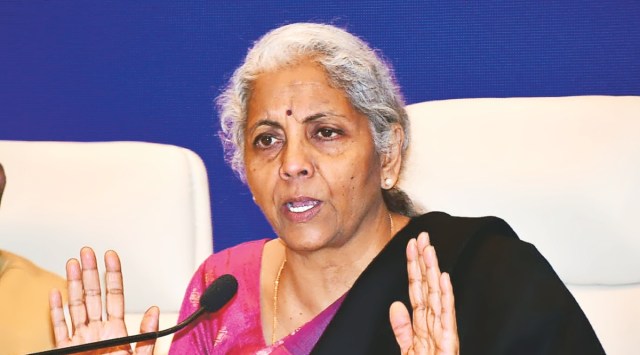Old vs new hotting up, Govt forms panel to relook at pension
The committee, which will be headed by Finance Secretary T V Somanathan, will work on an approach that will strike a balance between employees’ needs and fiscal prudence, with any changes proposed to be adopted by both Central and state governments.
 Union Finance Minister Nirmala Sitharaman. File
Union Finance Minister Nirmala Sitharaman. FileUNION FINANCE Minister Nirmala Sitharaman Friday announced the formation of a committee to look into improving the system of pension for government employees — a move that comes against the backdrop of at least five Opposition-ruled states adopting the Old Pension Scheme.
The committee, which will be headed by Finance Secretary T V Somanathan, will work on an approach that will strike a balance between employees’ needs and fiscal prudence, with any changes proposed to be adopted by both Central and state governments.
“Representations have been received that the National Pension System for government employees needs to be improved. I propose to set up a committee under the Finance Secretary to look into this issue of pensions and evolve an approach, which addresses the needs of the employees while maintaining fiscal prudence to protect the common citizens. The approach will be designed for adoption by both Central and state governments,” Sitharaman said.
She was speaking in the Lok Sabha during consideration of the Finance Bill, 2023, which was eventually passed with 64 amendments.
The move to form such a committee comes as Himachal Pradesh, Punjab, Rajasthan, Chhattisgarh and Jharkhand have reverted to the Old Pension Scheme (OPS), which offers defined benefits.
Earlier this week, the BJP-Sena (Shinde faction) government in Maharashtra also gave in-principle approval to extend monetary benefits of OPS to those under the NPS, with the state government likely to increase its share in the new scheme from 14 per cent to 20 per cent. At present, while the employee contribution to the scheme is 10 per cent, the government contribution stands at 14 per cent.
Under the NPS, which covers employees who joined service post January 2004, contributions are defined but benefits depend on the market. Earlier this month, the Central government informed Parliament that it is not considering any proposal to restore OPS in respect of its employees recruited after January 1, 2004. The Centre, however, allowed a one-time option to a section of government employees to shift to the OPS whose posts were advertised before the notification of the NPS in December 2003. Under the OPS, retired government employees get 50 per cent of their last drawn salary as monthly pension and the amount keeps increasing with hikes in dearness allowance rates.
The Indian Express had reported last month that Finance Ministry officials are exploring a model that combines elements of OPS and NPS, proposed by the YSRCP government in Andhra Pradesh.
Any decision by the Government will have to balance two key factors. It has to take into account political considerations with general elections coming in a year. At the same time, it has to be mindful of the fiscal burden linked to the old pension scheme.
As per the proposed pension model in Andhra Pradesh, called the ‘Guaranteed Pension Scheme’ or the GPS, employees can get a guaranteed pension of 33 per cent of their last drawn salary if they contribute 10 per cent of their basic salary every month which is matched by a 10 per cent contribution by the state government. They can get a guaranteed pension of 40 per cent of their last drawn salary, if they are willing to contribute a higher 14 per cent of their salary every month, which will be matched by 14 per cent government contribution.
The Central Government had introduced the NPS with effect from January 1, 2004, except for armed forces. High pension payouts add to the burden of the exchequer and have fiscal implications, which was also pointed out by the Government in the recent hearing related to One Rank One Pension in the Supreme Court.
In January, the RBI had cautioned states against reverting to the OPS stating that it will add to their fiscal burden. “The annual saving in fiscal resources that this move entails is short-lived. By postponing the current expenses, states risk the accumulation of unfunded pension liabilities in the coming years,” the RBI had said in its ‘Report on State Finances’.
As per the Budget estimates for 2022-23, states are expected to incur a 16 per cent rise in pension expenditure at Rs 4,63,436 crore in 2022-23 as against Rs 3,99,813 crore in the previous year.
- 01
- 02
- 03
- 04
- 05































